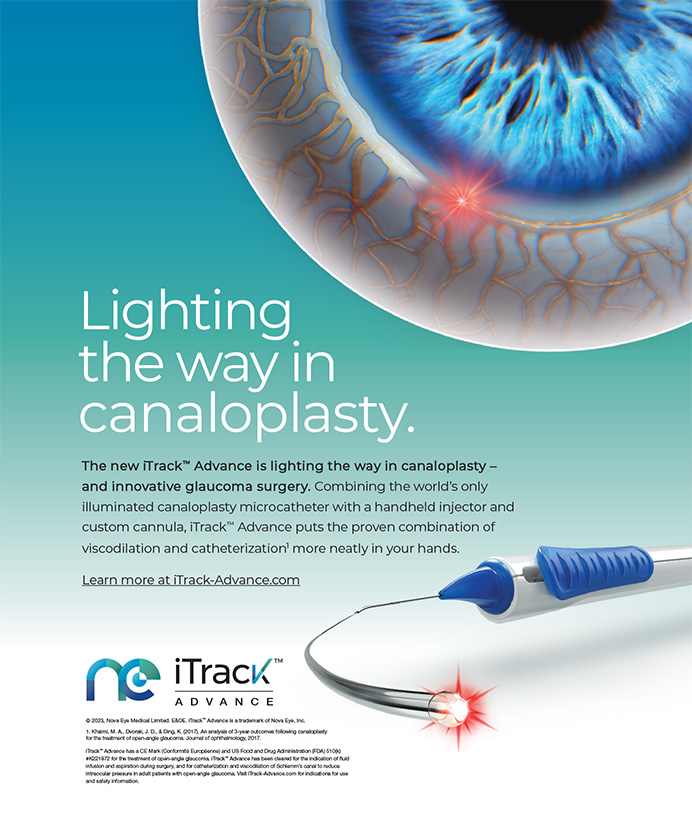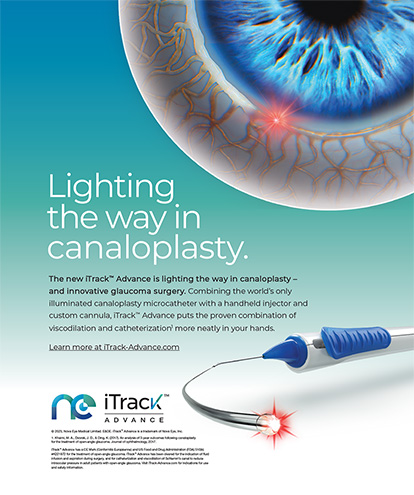During the past 2 decades, the array of treatment and vision correction options for patients with keratoconus has rapidly expanded. Historically, when individuals with keratoconus could no longer rely on glasses or rigid contact lenses, corneal surgeons could offer only penetrating keratoplasty. The introduction of scleral lenses, lamellar keratoplasty, and, most notably, CXL has transformed the contemporary approach to managing keratoconus. With CXL, we now have the potential to stop the progression of corneal ectasia before it results in vision loss or a permanent need for contact lenses. In this installment of the Fundamentals in Five column, Drs. Fonua and Ziaei provide a comprehensive review of CXL and its evolution over the past several decades.
Kavitha R. Sivaraman, MD


Keratoconus is a progressive, noninflammatory corneal degeneration that leads to corneal thinning, myopia, irregular astigmatism, and scarring. If severe enough, it can result in vision loss and disproportionately affect public health resources and quality of life.
The treatment of keratoconus has evolved significantly since the introduction of corneal CXL in the late 1990s. During CXL, UV-A light is applied to the cornea following its saturation with a chromophore—typically vitamin B2 or riboflavin. The primary purpose of treatment is to induce corneal stiffening, which halts ectasia progression.1
During the past 2 decades, there has been a diversification in CXL approaches encompassing a broad range of refined protocols and combined techniques. These developments are designed to optimize patient outcomes following CXL.
Our group recently conducted an extensive review of current CXL protocols and treatment methodologies.2 This article provides an overview of our findings.
1. DIAGNOSIS
Keratoconus diagnosis relies primarily on a set of objective parameters ascertained via slit-lamp examination, corneal tomography and OCT, epithelial thickness mapping, and aberrometry. No single parameter has been universally established as a definitive diagnostic indicator for disease development. Nevertheless, the global medical community concurs that the progression of ectatic conditions is contingent on at least two of the following criteria: steepening of the anterior and/or posterior surface and alterations in the pachymetric rate of change or thinning.3 The timeline within which disease progression is determined remains undefined, leading to diagnostic challenges. The clinician’s judgment and consideration of the patient’s unique risk factors are therefore paramount in diagnosing the progression of ectatic disorders.4
2. PATIENT SELECTION
CXL patient selection revolves mainly around the demonstrable progression of disease, with particular attention given to corneal thickness, corneal elevation maps, and visual acuity. The procedure is most often indicated for patients with progressive keratoconus, but its applications can be extended to other ectatic disorders such as pellucid marginal degeneration and degenerative corneal pathologies such as Terrien marginal degeneration.4 Recent advances have expanded the application of CXL beyond ectatic disorders. Studies are beginning to investigate the procedure’s potential benefits for patients with bacterial keratitis, bullous keratopathy, and progressive myopia as well as for those undergoing refractive surgery and keratoplasty.2
3. CXL TECHNIQUES AND PROTOCOLS
For many years, the standard in CXL treatment has been the Dresden protocol. Traditionally, a central 7 mm of the corneal epithelium was debrided, 0.1% riboflavin in 20% dextran applied, and UV-A irradiation (370 nm, 3 mW/cm2) of the cornea performed at a 1-cm distance for 30 minutes.5
Other protocols have since been described, including accelerated CXL. This method uses high-intensity UV-A radiation for shorter durations, effectively reducing patient discomfort and postoperative complications. A recent meta-analysis demonstrated that both the conventional and accelerated CXL protocols delivered comparable outcomes with similar safety profiles at 12 months.6
High-intensity UV-A exposure is thought to affect oxygen replenishment within the corneal stroma, influencing postoperative healing and the corresponding biomechanical response. Pulsed CXL protocols have been formulated to mitigate the issue. It has been postulated that intermittently applying UV-A radiation pulses as opposed to delivering continuous exposure can minimize side effects and enhance CXL efficacy.7
Transepithelial CXL was developed to mitigate postoperative complications related to epithelial debridement. Recent randomized controlled trials and systematic reviews comparing transepithelial and epithelium-off methods, however, have demonstrated similar or reduced efficacy compared with transepithelial techniques. This may be due to reduced riboflavin infiltration into the corneal stroma.2 To address this, iontophoresis-assisted CXL employs repulsive electromotive forces8—a process referred to as electromigration—to achieve a greater riboflavin saturation depth within the corneal stroma.
In a novel technique for patients with thin corneas, contact lens–assisted and SMILE lenticule–assisted CXL are techniques that can artificially enhance corneal thickness, broadening the pool of eligible candidates for treatment.9
Slit-lamp CXL has the potential to enhance CXL accessibility. A portable UV-A device mounted to a slit lamp in a clinic setting replaces the traditional surgical theatre or procedure room. The approach can improve patient access to treatment and minimize wait times while maintaining a comparable efficacy profile.10
4. COMBINED TREATMENTS TO OPTIMIZE OUTCOMES
CXL is recognized for its ability to stabilize and halt the progression of ectatic diseases, but patients often require supplementary correction with contact lenses or glasses to achieve their optimal visual acuity. Emerging treatment strategies—in an approach commonly referred to as CXL plus—aim to decrease the requirement for optical correction after CXL. Clinical trials of several protocols have ensued.
Athens protocol. The Athens protocol was first described by Krueger and Kanellopoulos.11 The corneal epithelium is debrided manually, and topography-guided PRK with a maximum ablation depth of 50 µm is performed to partially correct refractive error. The procedure is then completed with the application of 0.02% mitomycin C and conventional CXL.
Cretan protocol. The Cretan protocol12 deviates slightly in its methodology. The corneal epithelium is removed via transepithelial phototherapeutic keratectomy rather than manual debridement followed by conventional CXL. A variant of this protocol, termed the Cretan protocol plus, integrates a subsequent PRK step for additional refractive correction.13
Tel-Aviv protocol. The Tel-Aviv protocol is a modification of the Cretan protocol. Transepithelial phototherapeutic keratectomy is performed, followed by the correction of 50% of the manifest refractive astigmatism (on the same axis) with an option to add a spherical component and subsequent accelerated CXL.14
CXL plus protocols are promising. Numerous studies have demonstrated a substantial enhancement of patients’ visual acuity, but a definitive comparison with conventional treatment methods and a thorough evaluation of cost-effectiveness have not yet been completed.2
5. FUTURE DEVELOPMENTS AND ALTERNATIVE TREATMENTS
Since the procedure’s introduction in the late ‘90s, the indications and techniques for CXL have expanded rapidly with the emergence of numerous innovative applications.
A noninvasive method. An approach developed by Schaeffer et al obviates the need for corneal epithelial removal. The patient ingests a high dose of oral riboflavin and is subsequently exposed to natural sunlight for at least 15 minutes per day over 6 months.15
Customized CXL. Proposals to customize CXL treatment according to individual patient topography have been advanced. They have shown the potential for achieving corneal flattening comparable to that achieved with conventional CXL while significantly enhancing corneal surface regularization.16
Novel delivery methods. Investigational delivery methods include oxygen supplementation, which optimizes CXL outcomes,17 and antimicrobial photodynamic therapy, which boosts the eradication of microorganisms and enhances corneal drug delivery.18 The advent of more portable UV-A light–emitting devices, such as special spectacles and contact lenses, opens additional potential avenues for treatment.19,20
CONCLUSION
CXL has reshaped keratoconus management and encompasses a diverse array of evolving protocols and techniques. The procedure has a strong track record for the treatment of ectatic disease but has rapidly expanded into other areas. The future of CXL seems to be at our doorstep with advances in customized treatments based on individual patient characteristics specifically targeting the biomechanically compromised areas of the cornea. Ongoing advances have improved safety and efficacy while reducing time and procedure cost.
1. Randleman JB, Khandelwal SS, Hafezi F. Corneal cross-linking. Surv Ophthalmol. 2015;60(6):509-523.
2. Angelo L, Boptom AG, McGhee C, Ziaei M. Corneal crosslinking: present and future. Asia Pac J Ophthalmol. 2022;11(5):441-452.
3. Gomes JA, Tan D, Rapuano CJ, et al. Global consensus on keratoconus and ectatic diseases. Cornea. 2015;34(4):359-369.
4. Galvis V, Tello A, Ortiz AI, Escaf LC. Patient selection for corneal collagen cross-linking: an updated review. Clin Ophthalmol. 2017;11:657-668.
5. Wollensak G, Spoerl E, Seiler T. Riboflavin/ultraviolet-A–induced collagen crosslinking for the treatment of keratoconus. Am J Ophthalmol. 2003;135(5):620-627.
6. Kobashi H, Tsubota K. Accelerated versus standard corneal cross-linking for progressive keratoconus: a meta-analysis of randomized controlled trials. Cornea. 2020;39(2):172-180.
7. Ziaei M, Gokul A, Vellara H, Meyer J, Patel D, McGhee CN. Prospective two‐year study of clinical outcomes following epithelium‐off pulsed versus continuous accelerated corneal crosslinking for keratoconus. Clin Exp Ophthalmol. 2019;47(8):980-986.
8. Lombardo M, Serrao S, Lombardo G, Schiano-Lomoriello D. Two-year outcomes of a randomized controlled trial of transepithelial corneal crosslinking with iontophoresis for keratoconus. J Cataract Refract Surg. 2019;45(7):992-1000.
9. Srivatsa S, Jacob S, Agarwal A. Contact lens assisted corneal cross linking in thin ectatic corneas–a review. Indian J Ophthalmol. 2020;68(12):2773.
10. Hafezi F, Richoz O, Torres-Netto EA, Hillen M, Hafezi NL. Corneal cross-linking at the slit lamp. J Refract Surg. 2021;37(2):78-82.
11. Krueger RR, Kanellopoulos AJ. Stability of simultaneous topography-guided photorefractive keratectomy and riboflavin/UV-A cross-linking for progressive keratoconus. J Refract Surg. 2010;26(10):S827-S832.
12. Kymionis GD, Grentzelos MA, Kounis GA, et al. Combined transepithelial phototherapeutic keratectomy and corneal collagen cross-linking for progressive keratoconus. Ophthalmology. 2012;119(9):1777-1784.
13. Grentzelos MA, Kounis GA, Diakonis VF, et al. Combined transepithelial phototherapeutic keratectomy and conventional photorefractive keratectomy followed simultaneously by corneal crosslinking for keratoconus: Cretan protocol plus. J Cataract Refract Surg. 2017;43(10):1257-1262.
14. Kaiserman I, Mimouni M, Rabina G. Epithelial photorefractive keratectomy and corneal cross-linking for keratoconus: the Tel-Aviv protocol. J Refract Surg. 2019;35(6):377-382.
15. Schaeffer K, Jarstad J, Schaeffer A, McDaniel L. Topographic corneal changes induced by oral riboflavin in the treatment of corneal ectasia. Invest Ophthalmol Vis Sci. 2018;59(9):1413.
16. Sachdev GS, Ramamurthy S, Soundariya B, Dandapani R. Comparative analysis of safety and efficacy of topography-guided customized cross-linking and standard cross-linking in the treatment of progressive keratoconus. Cornea. 2021;40(2):188-193.
17. Seiler TG, Komninou MA, Nambiar MH, Schuerch K, Frueh BE, Büchler P. Oxygen kinetics during corneal cross-linking with and without supplementary oxygen. Am J Ophthalmol. 2021;223:368-376.
18. de Paiva ACM, Ferreira MDC, da Fonseca AS. Photodynamic therapy for treatment of bacterial keratitis. Photodiagnosis Photodyn Ther. 2022;37:102717.
19. Kobashi H, Torii H, Toda I, et al. Clinical outcomes of KeraVio using violet light: emitting glasses and riboflavin drops for corneal ectasia: a pilot study. Br J Ophthalmol. 2021;105(10):1376-1382.
20. Dackowski EK, Logroño JB, Rivera C, Taylor N, Lopath PD, Chuck RS. Transepithelial corneal crosslinking using a novel ultraviolet light-emitting contact lens device: a pilot study. Transl Vis Sci Technol. 2021;10(5):5.




